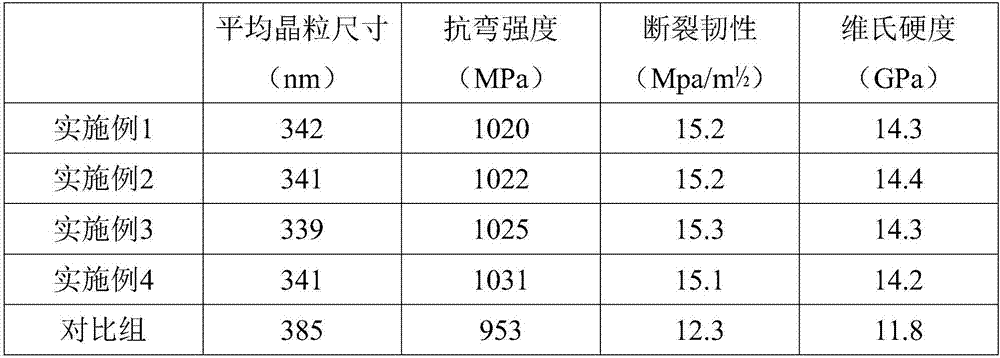Ceramic electric kettle and preparation method thereof
An electric kettle and ceramic technology, which is applied in the direction of boiling water utensils and other directions, can solve problems such as affecting the use and damage to the kettle body, and achieve the effects of being less prone to cracks, increasing the bonding force, and increasing the thermal insulation performance.
- Summary
- Abstract
- Description
- Claims
- Application Information
AI Technical Summary
Problems solved by technology
Method used
Image
Examples
Embodiment 1
[0019] A ceramic electric kettle, the ceramic kettle body is composed of the following raw materials in parts by weight: 80 parts of silicon dioxide, 30 parts of aluminum oxide, 12 parts of titanium oxide, 10 parts of zirconia, 13 parts of calcium carbonate, 10 parts of magnesium carbonate, 23 parts of talc 60 parts of clay, 30 parts of kaolin, 14 parts of silicon nitride, 8 parts of titanium carbide, 7 parts of strengthening agent, 7 parts of stabilizer, 1.8 parts of glaze, 40 parts of water;
[0020] The reinforcing agent is composed of the following raw materials in parts by weight: 22 parts of glass fiber, 30 parts of polyvinyl alcohol fiber, 15 parts of polybutylene terephthalate, 8 parts of phenolic foam, 16 parts of yttrium oxide, and 16 parts of chromium carbide .
[0021] The stabilizer is composed of the following raw materials in parts by weight: 12 parts of calcium oxide, 4 parts of magnesium oxide, 1 part of cerium oxide, 8 parts of copper oxide and 2 parts of man...
Embodiment 2
[0030] A ceramic electric kettle, the ceramic kettle body is composed of the following raw materials in parts by weight: 90 parts of silicon dioxide, 32 parts of aluminum oxide, 14 parts of titanium oxide, 12 parts of zirconia, 12 parts of calcium carbonate, 12 parts of magnesium carbonate, 25 parts of talc 50 parts of clay, 20 parts of kaolin, 16 parts of silicon nitride, 5 parts of titanium carbide, 5 parts of reinforcing agent, 10 parts of stabilizer, 1.9 parts of glaze, 45 parts of water;
[0031] The reinforcing agent is composed of the following raw materials in parts by weight: 20 parts of glass fiber, 35 parts of polyvinyl alcohol fiber, 10 parts of polybutylene terephthalate, 10 parts of phenolic foam, 18 parts of yttrium oxide, and 18 parts of chromium carbide .
[0032] The stabilizer is composed of the following raw materials in parts by weight: 15 parts of calcium oxide, 5 parts of magnesium oxide, 1 part of cerium oxide, 9 parts of copper oxide and 3 parts of man...
Embodiment 3
[0041] A ceramic electric kettle, the ceramic kettle body is composed of the following raw materials in parts by weight: 100 parts of silicon dioxide, 35 parts of aluminum oxide, 16 parts of titanium oxide, 15 parts of zirconia, 15 parts of calcium carbonate, 6 parts of magnesium carbonate, and 19 parts of talc 30 parts of clay, 40 parts of kaolin, 10 parts of silicon nitride, 7 parts of titanium carbide, 8 parts of strengthening agent, 8 parts of stabilizer, 1.7 parts of glaze, 55 parts of water;
[0042]The reinforcing agent is composed of the following raw materials in parts by weight: 25 parts of glass fiber, 40 parts of polyvinyl alcohol fiber, 15 parts of polybutylene terephthalate, 12 parts of phenolic foam, 14 parts of yttrium oxide, and 17 parts of chromium carbide .
[0043] The stabilizer is composed of the following raw materials in parts by weight: 14 parts of calcium oxide, 3 parts of magnesium oxide, 2 parts of cerium oxide, 6 parts of copper oxide and 2 parts o...
PUM
 Login to View More
Login to View More Abstract
Description
Claims
Application Information
 Login to View More
Login to View More - R&D Engineer
- R&D Manager
- IP Professional
- Industry Leading Data Capabilities
- Powerful AI technology
- Patent DNA Extraction
Browse by: Latest US Patents, China's latest patents, Technical Efficacy Thesaurus, Application Domain, Technology Topic, Popular Technical Reports.
© 2024 PatSnap. All rights reserved.Legal|Privacy policy|Modern Slavery Act Transparency Statement|Sitemap|About US| Contact US: help@patsnap.com








